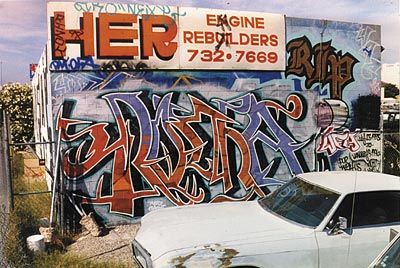My Drastic Masterpieces Smash Theses Through Telekenesis
Adventures of The Lactating Man
Lately I've been interested in off-kilter London act Infinite Livez, AKA Vinnie Tiefliz, who raps with a red one-eyed puppet named "Barry Convex" on his right hand. All of the songs on the debut LP Bush Meat are paranormal and infantile; one song and accompanying video are about a man who produces breastmilk in such volume that it floods the British isles, forcing people to travel on rowboats. Barry Convex and Infinite Livez duet on the album, in a relationship that's either endearingly childlike and surreal or Fucking Stupid. The beats are mature and laid back, and it sounds like straightforward, culture-positive hip hop until you listen to the surreal lyrics. By choosing an avatar that substitutes for adolescent power fantasies, hiding behind it rather than negotiating his own relationship with reality, and creating a comic book superhero fantasy as his "coming up" story, he's really no different than the Wu Tang Clan. As an independent comic book artist and video game designer, he's more conscious of the adolescent games that go into traditional hip hop narratives and thus hyper-accelerates them with gawdy bravado and toxic intensity. The rhyming is somewhat off-key and sloppy but with a lot of British hip hop, lyricism is second to delivery. Infinite Livez produces hip hop moments almost more surreal than Flava Flav fucking Bridgette Nielsen on VH1.

Here is an elucidating interview. Maybe.
Fox Airs Virgin Mary's Abortion Stuck On Clothes-Hangar! Pro-Life Groups Can't Figure Out Who to Crucify!
FCC fuhrer Micheal Powell announced his resignation on Friday, prompting a ten-minute rant on Howard Stern's show about the history of Powell's communications career and his lack of experience. (Stern claimed that Micheal Powell's apointment to the FCC and subsequent promotion was an attempt to court daddy Colin.) Make no mistake about it, Micheal Powell essentially put into place a structure that systematically empowered psychopaths. According to the new rules, even one phone call from an angry moron living in a trailer park, smoking crack-rock and protecting a refrigerator full of Gideon bibles and pickled testicles can result in hundreds of thousands of dollars in fines. (Yes I read the fine print and the thing about the pickled testicles is in there!) Jr Powell's FCC has scared networks into blurring animated anuses and restricting homo-faggot facetime on tv. Never has a system so effectively empowered the unstable, self-riteous and radical since Robbespierre's reign of terror during the French Revolution. Well maybe I'm being overdramatic, but it does disturb me that media content is effectively being regulated by anyone with a telephone and a fear of nipples. The result is that Stern's show has been very fun to listen to lately. The conservative clampdown has forced the show to return to the characteristics that made it stand out in the first place; anti-authoritarian values, and weird journeys between honesty and irony. I'm not sure whether I'm going to shell out the money and venture into Satellite Radio territory solely for the support of free speech, however. It feels almost like retreating, doesn't it?

Angels were 2 Men on a Mission
I watched Ghost In the Shell 2: Innocence on DVD because I wanted to ingest something that felt more like a multi-colored capsule than a movie, and I was all out of actual multi-colored capsules. I read reviews that said this film was abstract to the point of incomprehensibility, that it's pretentious and unbalanced and nonsensical. I have no fucking clue what any of those people were talking about. The narrative is straightforward, even humble in its simplicity (there can't be more than three or four major characters). The animation is lightyears beyond its predecessor. Character movements are fluid, like liquid flowing in between membranes, which is what animation should look like--ink bleeding in from another dimension. Character movements are rotoscoped to a point not dissimilar to old Disney or Fleisher Studios cartoon. (I just googled Fleisher studios and discovered that all of the original Superman cartoons are available online! These things are gorgeous-they touch the original majesty of the character better than any of the media properties that followed) The characters are hung against lush photorealistic CG, creating the illusion of realism and verisimilitude despite the typically stripped-down character designs of anime. Thankfully, the film is not about waxing Cartesian and problematizing the cognition of the Postmodern subject, although this is what it seems to be leaning towards at the begining of the film. ( This is, by the way, everything I didn't like about the original Ghost in the Shell: the overrought dialogue was about the "ghost" in the title; charmless babble about AI and existentialism. The "Shell" was reduced to cliched 80's cyborg on cyborg action movie type shit. The only time we see the "Shell" of the title play out is in a beautiful scene in which the major single-handedly battles a tank, resistant to the fact that she is overpowered, pushing her own body past its limits and destroying it in her frustration. The Shell poetically dissolves before our eyes.) Innocence is all about this Shell, which is feted over and fetishized to the point that we genuinely sympathize for the inanimate and material by the end, as they are catalogued and anthropomorphized by humans with imperial gusto.

The film features a character named Harraway who, like her academic namesake angsts over the ambiguities between silicon and flesh, human cognition and disembodied cognition. She is on the verge of basing her politics in that oblique space between Self and environment, the now cliched battleground of the postmodern feminist subject. (To cement the reference, Harraway pulls away her face to reveal that she is, in fact, a cyborg at the end of her scene.) I was skeptical that the film would become The Cyborg Manifesto on Ink, 2005, but this was only a tangent to the plot, a thesis tossed at the protaganists and the audience to contemplate later in the film. The actual story was much closer to Victoria Nelson's The Secret Life of Puppets-a wonderful history of the' projection of Self onto inanimate objects. In the SLOP (I just made that acronym right now!), Nelson constructs an epistemology of human avatars in fictions and reality, from Golem to Pinnochio to Frankenstein and to Cyborgs. Accurately historicizing (something Harraway doesn't seem to know how to do), Nelson argues that puppetry and marionettes are forms of 'disembodied information' that predate cyborgianism and perhaps one-up it in terms of communicative power and, I don't know, elegance. Distributed subjectivity in the form of AI and virtual environments are just part of a "periodic" paradigm shift in which our relationships to subjectivity are retinkered. In GITS:2 , director Oshii portrays puppetry and robotics as egotistical, disastrous affairs. The plot involves sexualized female robots, doll-like and fragile, that begin to spontaneously murder their owners. As a quivering girl cries beneath Batou's feet, freed from a module being prepared to be installed as a "ghost" into one of the robots, she says, "I don't want to be a doll!" Motoko coldly replies: "If the dolls could speak, no doubt they would say they never asked to be human". Morally, the film asks why we create our toys, our games, our dolls to look and act and feel like us, only to subject them to the coldness and cruelty we claim to hold contempt for. Aesthetically, the film showers us with creepy anomie; constantly displaying the uncanny in the form of lifeless, soulless husks with human bodies, flopping about an uncomfortable space between youth and death. The film reminds us of our own bodies, of the bizarre rituals we go through to reaffirm us of its use and what this ultimate insinuates about its fragility and its functionality. As the animators discuss on the making of clip, capturing the themes of the movie involved rendering characters counterintuitively to human movement; many of the subjects being animated are inanimate, thus normal human twitches and reactions are nulled, facial expressions glossed over and movement, however vibrant, become visually stilted and compact, evoking the frightening beauty of marionettes being tossed through the air.

I Shot Lilly Brick Down
My sister and her hubby are moving to Golden, Colorado next week and I offered to drive them there. Apparently it only takes two and a half days to drive from New York to Colorado. Fortunately I've spent the last few months finally acclimating myself to automobile-transport vehicles and can even drive them on highways without having small heart-attacks. I'll have a camera with me to blog the thrilling series of generic rest-stops-Roy Rogers, newsstand, arcade with four or five outdated games....America!


Charlie, Did I ever tell you the story about the president who got everything he ever wanted?
He lived happily ever after, surrounded by corpses and Nascar dads.
Thunderous Undies
I'm begining to think there's a link between the ascent of modern graffiti and the onset of globalization. This goes beyond privatized space and textual resistance; there's a root language that unites graffiti art and contemporary advertising. Branding and graf rely on forced associations, enacted through public spectacles that defer back to an intellectual property or a Self-Brand (a persona for graffiti writers.) The semiotics of branding/billboards/logos and the semiotics of graffiti are parallel because they are both languages birthed from late capitalism's redefinition of public and private space, a situation that favored references to an intangible identity over straightforward and declarative language. Maybe this all sounds obvious, but I'm suggesting that these two media are co-evolving, originate from the same cultural situation, and that studying either will reveal more about how we'll gradually be communicating with one another in the future. This is the stuff I've been reading/thinking about lately and want to do more long-term work on.

I Wrote the Book of Right-On
I'm on the record at Pixelsurgeon hating on the new Eminem album. I guess that's it.


0 Comments:
Post a Comment
<< Home